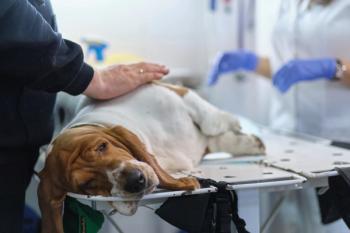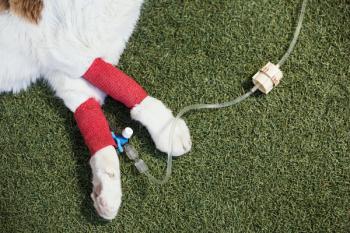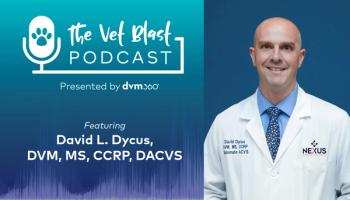
Dental devotion
New training center unveils plethora of opportunities for veterinarians interested in root of oral complications
Baltimore-The Animal Dental Training Center (ADTC) in Baltimoreprides itself as the first permanent training facility in private practiceworldwide devoted to teaching veterinary dentistry.
The center, headed by Ira Richard Luskin, DVM, dipl. AVDC, was completedin January 2000 when it gave its first mock exam to "would-be specialists."Starting this December, it will also begin offering master weekend coursesto advanced professionals in the field of veterinary dentistry.
"Initially, we found that what has been lacking in the educationalprocess in the United States is a very good, solid dental program at alluniversities," says Luskin, who currently teaches all courses at thecenter.
Luskin reports only three of 30 universities have a veterinary dentalspecialist who is teaching advanced dentistry.
"The rest of the schools still do not have programs that allow theseindividuals (students), when graduating, to have an understanding of dentistry,"he says.
The clear-cut goal for ADTC is that all attendees of the courses "leavethe center having achieved a proficiency of skills that can be put to useimmediately in practice."
Course structure
ADTC is presently housed in a 1,000 sq. ft. building in Baltimore whichalso contains the Animal Dental Center, a veterinary referral center, althoughboth operate independently of each other.
Many ADTC programs are designed with beginners and intermediates in mindand emphasize oral pathology and radiology, among other topics. Studentscan apply dental radiograph technology, which is available at the centerand aids in formulating the dental treatments.
"There's a whole plethora of levels as well as disciplines thatare covered by the center," he says.
In addition to monthly beginner and intermediate classes, which are typicallyeight-hour sessions (two hours of lectures and six-plus in wet labs), thecenter will offer weekend master classes beginning in December coveringoral surgery, orthopedics, crown and orthodontics, periodontics, endodontics,and restorative techniques. These master classes will be taught by any offive faculty Luskin has appointed.
Currently, the center can handle up to 26 people in the wet labs.
Attendees are provided with high speed/low speed equipment and any otherinstrumentation they might need to accomplish the individual procedurestaught in the class.
"Everything to run a full dental operatory is on-site," Luskinsays, which includes drills, full equipment for oral surgery, surgical instrumentation,things for restorative (such as making crowns). His investment was closeto $100,000.
Veterinarians can earn up to 13 C.E. credits in a session at the beginner,intermediate or advanced levels.
Oral surgical courses start out with simple, conventional extractionsand provide indications for various extractions. Then the courses transitionto surgical extractions and teach about using mucogingival flaps to closeholes. Course matter also extensively covers tumors (the third most commonarea for cancer is the oral cavity.)
"Veterinarians can apply these courses in their practice immediately.This is not academic," explains Luskin.
Late bloomer
Luskin is not surprised that it was not until 2000 before a dental trainingcenter at the private level was opened.
It follows the path of the profession.
Not until 1988 did the American Veterinary Medical Association firstformulate the American Veterinary Dental College (AVDC) which was approvedto give its first specialty certifying exam, according to Luskin.
Dr. Frank Verstraete, secretary of the AVDC, prefers not to speculatewhy the AVDC was not formed until 1988, when specialties such as cardiologyhad been existence for more than 15 years at that time.
"It's water under the bridge," he explains.
Prior to the AVDC, Verstraete and Luskin were among 24 founding fathersof the Academy of Veterinary Dentistry, which initially gave certifyingexams. Although still in existence today, Verstraete says the Academy isnot recognized by the AVMA. He declined further comment.
However, he does mention that through the years the specialty of dentistryhas slowly begun to increase, which may attribute to the late dates forformal establishment of the specialty.
"The main reason why it is slow (in growth) is that it is largelya private-practice based specialty," says Verstraete. "Very fewuniversities have a veterinary dental program."
And the number of those in the profession is modest.
There are only 54 diplomates (AVDC) in the world (45 in the U.S., 6 inCanada), so some states have absolutely no specialists and others mighthave three or four, says Luskin. About 28 are estimated to have their ownspecialty referral facilities and 17 are likely in industry or at universities.
Diverse audience
The ADTC caters to three groups: veterinarians with no education in dentistry,those who have some background in dentistry and those working toward specialtylevels.
The goal of all programs is intense training that can be immediatelyapplied in practice. Luskin says, in addition, interaction among attendeesand himself is also extremely vital.
"The training center allows people to get together and discuss whatthey are doing in practice, because they are there the whole day interactingthe whole time," says Luskin.
"Since I'm not coming from the academic ivory towers but from aclinical level, my ability to recommend things they can do to enhance theirdevelopment of their dental practice in their individual facilities is basedon practicality - dollars and cents," he says. "It's a no-holdsbarred situation where they can ask me anything involving dentistry throughoutthe lectures.
"They have my e-mail and telephone number - it goes way beyond justa day at the center. This is where I bond to the individual practitioner.I've always enjoyed teaching and since I think I'm gifted in that area,the training center was really established because there was nothing availablein the downtimes between local seminars."
Another asset to the private practitioner is that the courses are designedto help veterinarians develop a profit center in dentistry, according toLuskin.
"The only way they can do that is if they fully adhere to understandingthe ramifications involved with diagnosis and treatment of oral disease,"he explains. "What I hope to do is bring up the general level of understandingfor those people who have the time and interest in dentistry."
Luskin recalls more than one occasion where practitioners would calland tell him lines such as they had been practicing "30 years of absolutechicanery when it came to oral disease."
"They feel very ill-prepared initially," Luskin says.
The story changes after a course or two.
"They feel a lot more confident in being able to help diagnose problemsand treat them appropriately," he says.
Growth for the center is out of the question at the moment.
"In order for me to grow the facility, I'd have to clone myself,"he says.
For more information, contact Luskin at (410) 866-3131 or e-mail adcvet-training@aol.com.
Newsletter
From exam room tips to practice management insights, get trusted veterinary news delivered straight to your inbox—subscribe to dvm360.



